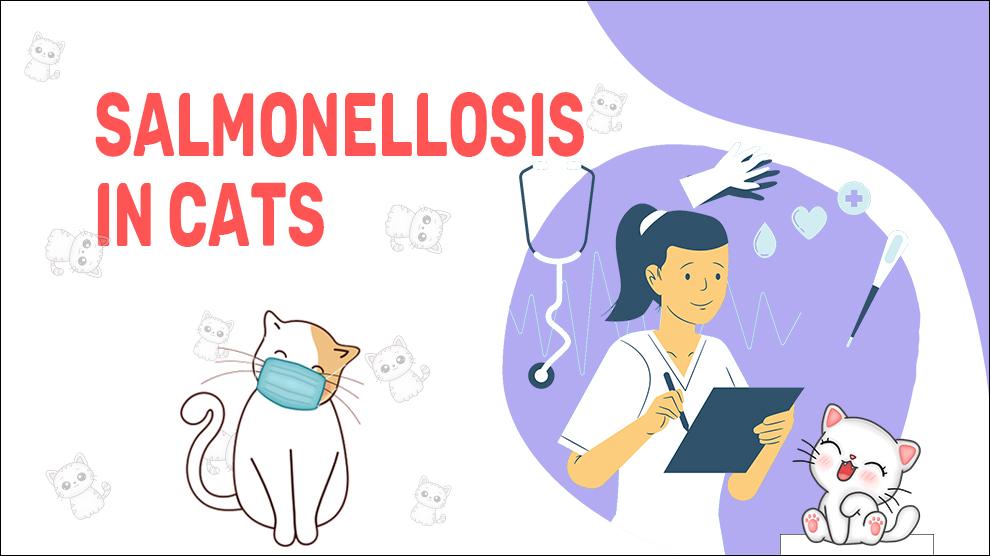What Is Salmonellosis In Cats?
Salmonellosis is a bacterial infection caused by Salmonella bacteria. While it can affect many different animals, including humans, cats can also be vulnerable to this disease.
It is typically transmitted through the consumption of contaminated food or water, or through contact with infected animals or their feces.
Clinical Signs Of Salmonellosis In Cats
Symptoms of salmonellosis in cats can vary depending on the severity of the infection.
Some of the most common symptoms include:
- Diarrhea
- Vomiting
- Fever
- Loss of appetite
- Lethargy
- Dehydration
- Abdominal pain
- Weight loss
- Bloody stools
- Shock
- Mucus Stool
- Depression
- Weakness
- Enlarged Lymph Nodes
- Rapid Heartbeat
- Vaginal Discharge
- Bloody Vaginal Discharge
- Licking Rear
In severe cases, salmonellosis can cause septicemia and other complications, which can be life-threatening.
Treatment Options For Salmonellosis In Cats
Treatment for salmonellosis in cats typically involves antibiotics to help eliminate the bacteria.
Supportive care, such as fluid therapy and nutritional support, may also be necessary to help manage the symptoms of the disease. In severe cases, hospitalization may be required to provide more intensive treatment.
It is important to note that antibiotics may not be effective in all cases of salmonellosis, and some strains of Salmonella may be resistant to certain antibiotics.
It is important to work closely with a veterinarian to determine the best course of treatment for your cat.
Home Remedies For Salmonellosis In Cats
It is not recommended to treat Salmonellosis in cats at home as it can lead to severe complications. It is important to consult a veterinarian for proper diagnosis and treatment.
How To Prevent Salmonellosis In Cats?
Preventing salmonellosis in cats involves proper hygiene and handling of food.
Some key prevention strategies include:
- Washing hands thoroughly with soap and water before and after handling cats, their food, or their litter boxes.
- Feeding cats high-quality, commercially produced cat food.
- Keeping food and water bowls clean and disinfected.
- Avoiding feeding cats raw or undercooked meat or eggs.
- Keeping litter boxes clean and disinfected.
- Washing bedding, toys, and other items that come into contact with cats regularly.
Affected Cat Breeds Of Salmonellosis
Salmonellosis can affect cats of all breeds and ages. However, kittens, older cats, and cats with weakened immune systems are more susceptible to the disease.
Causes For Salmonellosis In Cats
Causes:
Salmonella bacteria are the main cause of salmonellosis in cats. These bacteria are commonly found in the intestines of many animals, including cats, and can be shed in feces.
The bacteria can also contaminate food and water sources, as well as surfaces and objects that have come into contact with infected animals or their feces.
Cats can become infected with Salmonella by consuming contaminated food or water, or by coming into contact with infected animals or their feces.
Kittens and older cats, as well as those with weakened immune systems, are at higher risk of infection.
When To See A Vet For Salmonellosis In Cats?
If you suspect your cat may have salmonellosis, it is important to seek veterinary care right away.
Symptoms of salmonellosis can be similar to those of other diseases, and a veterinarian can help determine the underlying cause of your cat's symptoms and develop an appropriate treatment plan.
Food Suggestions For Salmonellosis In Cats
To prevent Salmonellosis in cats, it is recommended to feed them a well-balanced and healthy diet that is free from contaminated raw meat, eggs, and other poultry products.
Always ensure that the food you feed your cat is cooked thoroughly to kill any bacteria present.
Conclusion
Salmonellosis is a serious bacterial infection that can cause severe complications in cats if left untreated.
It is important to recognize the symptoms and seek immediate veterinary care to prevent the spread of the disease to other animals and humans.
Preventative measures such as proper hygiene, cleaning, and disinfection of the cat's living area, as well as providing them with a well-balanced and healthy diet, can help reduce the risk of infection.
If you suspect that your cat has Salmonellosis, seek veterinary care immediately for proper diagnosis and treatment.











